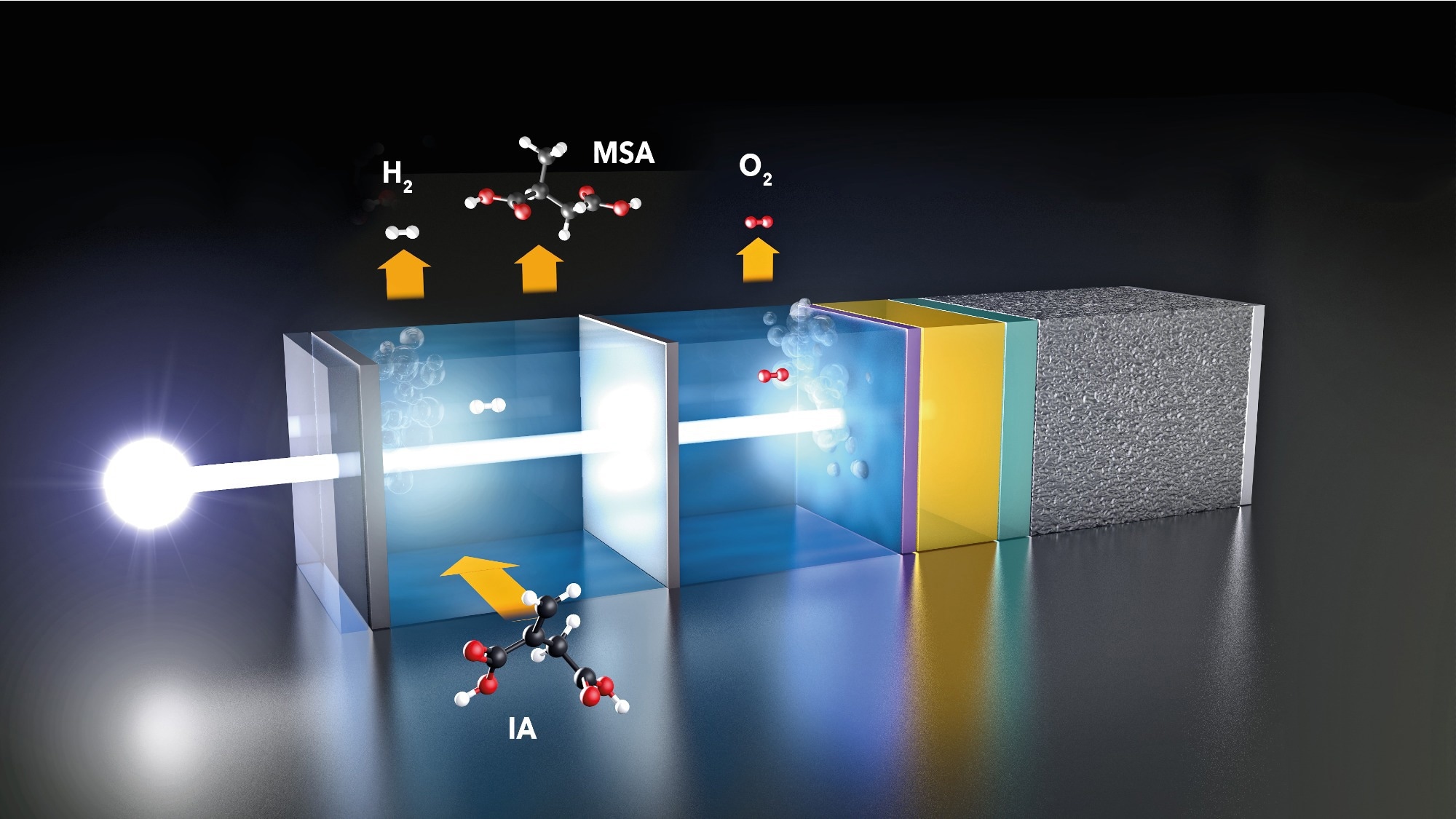In photoelectrochemical (PEC) cells, sunlight could be employed to directly produce green hydrogen from water. Until now, systems based on this “direct approach” have not been competitive in terms of energy.

The photoelectrochemical cell: Sunlight generates a photovoltage in the catalyst-coated solar cell (right), which splits water molecules. Hydrogen is produced at the left electrode, oxygen at the right. A part of the H2 reacts further with itaconic acid (IA) to form valuable methyl succinic acid (MSA). Image Credit: © M. Künsting/Helmholtz-Zentrum Berlin
When some of the hydrogen in such PEC cells is utilized in situ for a catalytic hydrogenation reaction, the balance shifts, resulting in the co-production of chemicals utilized in the chemical and pharmaceutical industries. According to the research, the energy payback time of photoelectrochemical “green” hydrogen production can be drastically reduced.
Hydrogen can be produced through water electrolysis, preferably with solar cells or wind power, providing adequate electrical energy. This “green” hydrogen is expected to play a key role in the future energy system.
Solar water splitting has made significant progress over the last decade: the best electrolyzers, which attract the required voltage from PV modules or wind power, can now attain efficiencies of up to 30%. This is the indirect method.
The Direct Approach
Several groups at the HZB Institute for Solar Fuels are collaborating on a direct approach to solar water splitting. They are constructing photoelectrodes that transform sunlight into electrical energy, are stable in aqueous solutions, and encourage water splitting catalytically. Light absorbers are intently coupled to catalyst materials to form the active component of a photoelectrochemical cell (PEC) in these photoelectrodes.
The best PEC cells, which use low-cost and stable metal oxide absorbers, already achieve efficiencies of around 10%. Although PEC cells are still less effective than PV-driven electrolyzers, they have significant advantages: for instance, heat from sunlight can be used to expedite reactions in PEC cells.
Since current densities are ten to a hundred times lower with this strategy, abundant and low-cost materials can be used as catalysts.
Not Yet Competitive
Techno-economic analyses (TEA) and net energy assessments (NEA) have revealed that the PEC strategy is not yet cost-effective for large-scale implementation. Today, hydrogen from PEC systems costs about 10 USD/kg, which is roughly six times more expensive than hydrogen from fossil methane steam reforming (1.5 USD/kg).
Furthermore, the total energy demand for PEC water splitting is expected to be 4–20 times that of hydrogen production using wind turbines and electrolyzers.
The Idea: Co-Production of Valuable Chemicals
“This is where we wanted to bring a new approach,” states Dr. Fatwa Abdi from the HZB Institute for Solar Fuels. Within the framework of the UniSysCat excellence network partnership between Prof. Reinhard Schomäcker and Prof. Roel van de Krol, Abdi’s team examined how the balance alters when some of the hydrogen produced reacts further with itaconic acid (IA) in the same reactor (in situ) to form methyl succinic acid (MSA).
Energy Payback Times
Researchers first estimated how much energy is required to manufacture the PEC cell from light absorbers, catalyst materials, and other materials like glass, as well as how long it must operate in order to generate this energy in the form of chemical energy as hydrogen or MSA.
This “energy payback time” for hydrogen alone is around 17 years, assuming a modest 5% solar-to-hydrogen efficiency. If only 2% of the hydrogen produced is used to transform IA into MSA, the energy payback time is cut in half, and if 30% of the hydrogen produced is converted into MSA, the production energy can be recovered in just 2 years.
“This makes the process much more sustainable and competitive,” notes Abdi. One reason is that the energy required to synthesize MSA in such a PEC cell is only one-seventh of what traditional MSA production processes require.
A Flexible System
The system is flexible and can also produce other valuable chemicals that are currently needed at the site.
Dr. Fatwa Abdi, Institute for Solar Fuels, Helmholtz-Zentrum Berlin
The fixed components of the PEC unit, which account for the majority of the investment costs, remain unchanged; only the hydrogenation catalyst and feedstock must be exchanged.
This approach offers a way to significantly reduce the production cost of green hydrogen and increases the economic feasibility of PEC technology. We have carefully thought through the process, and the next step is to test in the laboratory how well the simultaneous production of hydrogen and MSA works in practice.
Dr. Fatwa Abdi, Institute for Solar Fuels, Helmholtz-Zentrum Berlin
Journal Reference
Zhang, X., et al. (2023). Life cycle net energy assessment of sustainable H2 production and hydrogenation of chemicals in a coupled photoelectrochemical device. Nature Communications. doi.org/10.1038/s41467-023-36574-1.